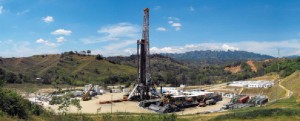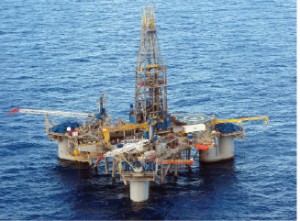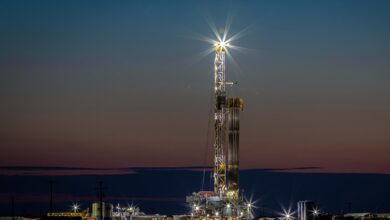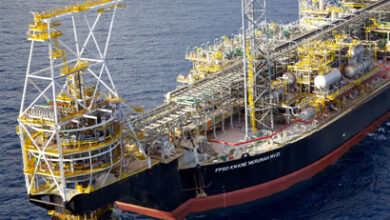Mexican, South American fortunes sway with the global tide
By Jerry Greenberg, contributing editor

Like many oil and gas regions of the world, and the many companies that operate in them, Mexico and many South American countries are not immune to the effects of the global economic downturn. While many Latin American countries remain fairly active in terms of drilling activity, whether by national oil companies, private investment or both, the significantly lower oil prices – compared with 2008 – have resulted in reduced exploration and production in many areas.
However, many private companies, mainly smaller independents, and from all over the world, continue to explore for oil and gas in countries like Mexico, Colombia, Ecuador, Uruguay, Venezuela, Brazil, Argentina and offshore the Falkland Islands (which has stirred controversy between Argentina and the UK). Many operators are reporting successes.
On the rig side of the equation, the economic downturn has resulted in fewer rigs working in many regions, and Mexico and South America are no exception. For example, there is concern that Pemex may be working significantly fewer jackups this year and beyond than it has traditionally contracted. And Brazil, which seems to announce a significant offshore discovery several times a week, is embarking on a dramatic increase of its deepwater rig fleet; yet one caveat has drilling contractors concerned.
Drilling contractors are facing some of the same issues onshore. Countries that had supported a dozen land rigs for one contractor now has demand for fewer than half that. As a result, the number of idle rigs has made it extremely difficult to move rigs from one country to another, or even from one region to another in the same country.
MYSTERIOUS MEXICO
Mexico really isn’t mysterious; there is just much speculation over what Pemex will do regarding its fleet of contracted jackups and how many more or fewer it will require in the near future. Speculation also runs over the number of semisubmersibles Pemex needs.
As far as jackups, recent speculation was that Pemex may be planning only about 10 new offshore exploration programs during 2010, meaning its fleet of jackups would continue shrinking, keeping the rigs it needs by offering contract extensions. In February 2010, for example, Pemex was contracting 26 jackups, according to figures from ODS-Petrodata, compared with the company’s peak demand of 34 jackups in August 2009.
Most of the jackups being released by Pemex are mat-supported units that don’t fit into the company’s plans. Two more mat-supported rigs were released this February. In a recent report, ODS-Petrodata said that, while some drilling contractors are more bullish than others, as of February there were 16 jackups scheduled to come off contract by the end of 2010.
On the other hand, ODS-Petrodata also reported that Pemex may be about to tender for as many as five jackups for contracts to begin between June and November 2010, although that doesn’t necessarily mean an additional five jackups will enter the region.

Noble Drilling, which has most of its jackups operating offshore Mexico for Pemex, is one of those bullish contractors. Roger Hunt, senior vice president, operations for Noble, said during the company’s earnings conference call in February that “there has been a lot of confusion around Pemex’s plans for the upcoming year in terms of renewals. Some have been concerned that we could see a dramatically reduced jackup count, but we remain optimistic that Pemex will continue to need good-performing assets . . . to help offset some of their (production) decline issues.
“We feel very good about Mexico,” Mr Hunt continued. “We believe all of our incumbent rigs in Mexico will stay there, and we’ll work through the bid process. We’re confident that bid requests for extensions of our rigs, subject to us getting the pricing right, will result in our rigs staying in Mexico.
“Our understanding is that Pemex is working on bid packages with the goal of publishing them in the very near future,” he added. “Our position in Mexico as an incumbent is a very strong one.”
In fact, Noble received contract extensions and increased dayrates for the Noble Eddie Paul and Noble Leonard Jones and was expecting contract extensions for the Noble Lewis Dugger and Noble John Sandifer.

ENSCO International is operating five jackups in Mexico, four of which are contracted through various dates in 2012. One contract expires in June 2010. “(Pemex) has a tender coming out for five independent-leg cantilever units shortly,” said Sean O’Neill, vice president of investor relations for ENSCO. “It looks like they will be for incumbent rigs, and we will be very actively bidding.”
On the deepwater side, Mr O’Neill said Pemex is in the early stages but that deepwater activity will increase. “There is so much activity in the US Gulf,” he said. “There is no reason to believe that the geology is significantly different only a relatively short distance away.
“We think there is going to be potentially very good demand for deepwater drilling in Mexico,” Mr O’Neill concluded.
Nabors International has six land rigs in Mexico in addition to one jackup (which is idle) and nine platform rigs. “We are looking at several opportunities for onshore Mexico,” said John Gass, senior vice president, business development and contracts for Nabors International Management.
Nabors’ platform rig business in Mexico appears strong, and there could be opportunities to increase their platform rig fleet. Presently the company is operating five of its 1,000-hp Sundowner platform rigs and four 2,000-hp MACE platform rigs offshore Mexico.
“We are looking for at least two more of the 2,000-hp and probably three more of the 1,000-hp whenever Pemex gets their budgeting worked out,” Mr Gass said. “We feel like it will be this year.”
Helmerich & Payne IDC also is active onshore Mexico with six rigs, all working for Schlumberger in northern Mexico under two-year contracts. Schlumberger has a service contract with Pemex whereby the service company is responsible for the entire well.
“We have participated actively in the bidding process during the past 12 months,” said H&P director of investor relations Juan Pablo Tardio. “However, recently the bidding activity has declined.”
BRAZILIAN DEEPWATER
Petrobras has always been one of the world’s most active deepwater and ultra-deepwater companies, in Brazil and other regions. The Brazilian national oil company is making plans to continue that effort even as it is increasing its E&P efforts in shallow waters and, to a certain extent, onshore. Petrobras recently awarded FMC Technologies a four-year subsea tree frame agreement worth about $400 million if all 107 subsea trees and related tools are ordered. The systems and equipment would be built at FMC’s facility in Brazil.
The company’s latest program is a dramatic increase in its deepwater rig fleet, but this time, rather than pursuing contracts for existing floating drilling rigs, its plan is to build nine rigs that Petrobras will own and an additional 19 new rigs that would be owned by drilling contractors and contracted by Petrobras. The rigs would be capable of drilling in up to about 10,000 ft of water. Delivery dates would be between 2014 and 2017. Bid tenders for these rigs were to have been submitted to Petrobras by March 2010.

A significant issue is that Petrobras wants all of the rigs to be built in Brazilian shipyards with very high Brazilian content. Kevin Robert, senior vice president, marketing and business development for Pride International, said during the company’s earnings conference call in February, “These tenders require all of the rigs to be built in Brazil, which is very ambitious given the limited construction capacity in the country.”
Pride president and CEO Louis Raspino, 2010 IADC chairman, said during the company’s conference call, “While Petrobras is a great client, and we’re working very hard to determine a way to help them achieve their strategic objectives, the project as currently defined presents a risk profile to drilling contractors, both from the shipyard side as well as the drilling contract side, that may be difficult to surmount at an acceptable dayrate to Petrobras.”
Noble’s Mr Hunt noted, “One might argue that the pricing on these projects is going to be considerably greater than building the units outside Brazil, which will result in dayrates that could be quite a bit higher than Petrobras has historically been prepared to pay.”
“If the tender as structured doesn’t yield the results that (Petrobras) is looking for, I don’t think their default position is to go to the world market and buy rigs,” Mr Raspino said. “I think their default position is to try to redefine the tender to get what they are looking for.”
Addressing the shipyard capacity issue, Jurong Shipyard will build a new yard in Brazil that will be capable of constructing drillships, semisubmersibles, FPSO integration, topside modules and platform supply vessels, in addition to traditional repair and modification projects. The company purchased land with 1.6 km of coastline in Espirito Santo state, though it’s unclear when the shipyard would be completed.
Meantime, Diamond Offshore was awarded three term drilling contracts from Petrobras that represent at least 11 years of contract drilling backlog. The Ocean Valor will mobilize from Singapore to Brazil and the Ocean Baroness will mobilize from the US Gulf. The Ocean Clipper is already working for Petrobras in Brazil under a contract due to expire in December 2010.
Additionally, Petrobras decided to use the Ocean Courage in Brazil rather than in the US Gulf as originally planned. The new rig is already contracted to 2015.
All four rigs are scheduled to be in Brazil this year.
VENEZUELA
Venezuela isn’t the easiest place to work for operators, and it’s not much easier for drilling contractors. Nabors is operating four rigs in the country, all contracted to mixed operators; that is, the national oil company, PDVSA, is in a joint venture with other companies, typically with the involvement of a private international oil company, some of which are still active in the country.

For example, two of Nabors’ four rigs are working for a venture that includes Chevron and PDVSA while two others are working for a joint venture of Statoil, Total and PDVSA. In each case, according to Nabors, it is paid by the joint venture rather than by PDVSA directly.
Each of the rigs is working on three-year contracts at dayrates ranging between $38,000 and $42,000, according to Mr Gass.
There are potentially more opportunities. “As an OPEC country and with their production declining rapidly,” Mr Gass explained, “they have to begin drilling and get some investment in the country.
“I believe Venezuela will always have opportunities,” he said. Nabors presently is negotiating with another group that could result in two more rigs in Venezuela.
Helmerich & Payne has had the opposite experience. The company has 11 land rigs in Venezuela, all idle. They were contracted to PDVSA, but, due to financial difficulties, the company still owes the contractor. H&P noted in a presentation on its website that, as of 29 January 2010, the total invoiced amount that remains due from PDVSA is valued at approximately US$51 million, including approximately $43 million in invoices issued since the company changed its revenue recognition to a cash basis for its Venezuelan operations.
The company noted in its fiscal Q1 2010 10-Q report (H&P’s fiscal year ends 30 September) that the ability to collect accounts receivables in US dollars from PDVSA deteriorated to the point that during Q2 of fiscal 2009, the company decided to discontinue work as the rig contracts expired. As a result, all 11 rigs were idled.
ARGENTINA
Argentina is a country that has experienced a dramatic decrease in E&P activity since the 2008 peak. Nabors is operating 20 rigs in the country, down from 23 rigs at one point last year, according to Mr Gass. Nabors recently moved in a rig from Bolivia to Argentina because it was only about 30 miles away from the rig site and was more economical than mobilizing a rig already in the country.
There doesn’t appear to be much to attract drilling contractors to the country. “It’s very much a commodity market (for rigs),” Mr Gass explained. “Dayrates are very low, and right now we are trying to keep utilization (high) because of ongoing labor costs.
“There are no opportunities until (the government) changes its politics,” Mr Gass continued. “Even some of the international oil companies are leaving because (the government) caps the price of oil, so they are not market prices.”
H&P also has experienced downtime in Argentina. At the end of January 2010, the company reported five of nine rigs active there. “It is a matter simply of demand in the country,” Mr Tardio said. “Our idle rigs are large 2,000- to 3,000-hp rigs, and demand for that specific type of rig declined significantly.”
Mr Tardio noted that the price of natural gas is a key element that affects rig demand and that the government participates in the regulation of natural gas prices. “(Natural gas prices) in Argentina are not market-driven, and we find that the local market is experiencing a lot of challenges in that regard,” he said.
Also in Argentina, several operators are chartering Diamond Offshore’s semisubmersible Ocean Guardian to drill as many as seven wells offshore the Falkland Islands (or the Malvinas Islands if you’re from Argentina). There may be additional wells if options are taken. Operators drilling north of the islands include Desire Petroleum, Rockhopper Exploration and BHP Billiton. Some estimates place the amount of oil around the islands at 60 billion bbls. It makes one wonder why there hasn’t been a larger effort to discover and exploit that amount of oil before now.
COLUMBIA
Colombia is an active E&P area because, among other reasons, it allows foreign companies to take exploration concessions. As a result, the country has frequently been in the news as companies make a discovery or prepare to commence a drilling program. Among the active companies are Ecopetrol, Petrobras, Amerisur Resources, Alange Energy, Pacific Rubiales, PetroLatina, Suroco Energy, Global Energy Development, Petrominerales, Petroamerica and InterOil.
Additionally, the Colombian National Agency of Hydrocarbons is promoting investment in the country’s oil and gas sector, with another licensing round that includes more than 225 blocks in 22 basins. E&P efforts have attracted high investment levels and exploration results. The government agency noted that foreign investment was about $3.5 billion in 2008 and $3.89 billion in 2009, and it expects that figure to increase this year. The agency also said that nearly 50% of the blocks that were explored in 2008 and 2009 yielded positive results.
Nabors is operating 10 land rigs in Colombia, most with state oil company Ecopetrol, and has a contract with Petrobras in the country. The company recently was awarded a contract from Ecopetrol for eight additional rigs. It will be fulfilled with four rigs that will be newly built in China, two upgraded rigs from the US and two rigs already in Colombia. All will have three-year contracts with dayrates ranging between $30,000 and $34,000.
And there likely are additional opportunities for more rigs. “Colombia is pushing to increase its production,” Mr Gass said, “and even Ecopetrol has a very aggressive spending program. They are going to spend over $60 billion during the next eight years, and the foreign oil companies are spending record-high amounts.
“Colombia has put a lot of plans in place to increase oil production, and they have seen the benefits.”





2 Comments